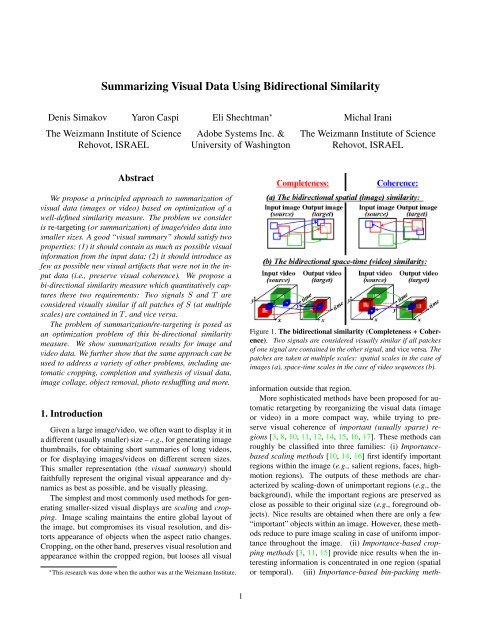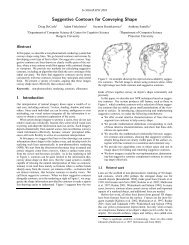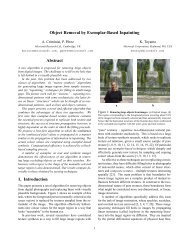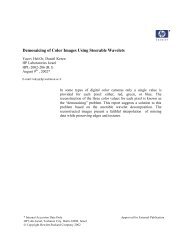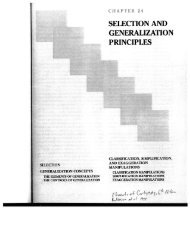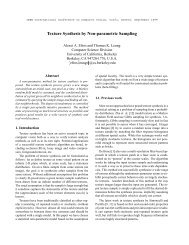Summarizing Visual Data Using Bidirectional Similarity - Faculty of ...
Summarizing Visual Data Using Bidirectional Similarity - Faculty of ...
Summarizing Visual Data Using Bidirectional Similarity - Faculty of ...
You also want an ePaper? Increase the reach of your titles
YUMPU automatically turns print PDFs into web optimized ePapers that Google loves.
pˆjPˆjS(ource)completenesspiPiQˆjcoherenceFigure 3. Notations for the update rule.T(arget)qQicolor. We first isolate the contribution <strong>of</strong> the color <strong>of</strong> eachpixel q ∈ T to the error d(S, T ) <strong>of</strong> Eq. (1).The error a pixel q ∈ T contributes to d cohere (S, T ):Let Q 1 , . . . , Q m denote all the patches in T that containpixel q (e.g., if our patches are 7 × 7, there are 49 suchpatches). Let P 1 , . . . , P m denote the corresponding (mostsimilar) patches in S (i.e., P i = arg min P ⊂S D(P, Q i )).Let p 1 , . . . , p m be the pixels in P 1 , . . . , P m correspondingto the position <strong>of</strong> pixel q within Q 1 , . . . , Q m (see Fig. 3).Then 1 ∑ mN T i=1 (S(p i) − T (q)) 2 is the contribution <strong>of</strong> thecolor <strong>of</strong> pixel q ∈ T to the term d cohere (S, T ) in Eq. (1).The error a pixel q ∈ T contributes to d complete (S, T ):Let ˆQ1 , . . . , ˆQ n denote all the patches in T that containpixel q and serve as “the most similar patch” tosome patches ˆP 1 , . . . , ˆP n in S (i.e., ∃ ˆP j ⊂ S s.t. ˆQ j =arg min Q⊂T D( ˆP j , Q)). Note that unlike m above, whichis a fixed number for all pixels q ∈ T , n varies from pixel topixel. It may also be zero if no patch in S points to a patchcontaining q ∈ T as its most similar patch. Let ˆp 1 , . . . , ˆp nbe the pixels in patches ˆP 1 , . . . , ˆP n corresponding to theposition <strong>of</strong> pixel q within ˆQ 1 , . . . , ˆQ n (see Fig. 3). Then1N S∑ nj=1 (S(ˆp j) − T (q)) 2 is the contribution <strong>of</strong> the color<strong>of</strong> pixel q ∈ T to the term d complete (S, T ) in Eq. (1).Thus, the overall contribution <strong>of</strong> the color <strong>of</strong> pixel q ∈ Tto the global bidirectional error d(S, T ) <strong>of</strong> Eq. (1) is:1Err(T (q)) =n∑N Sj=1(S(ˆp j ) − T (q)) 2 + 1N Tm∑i=1(S(p i ) − T (q)) 2 . (4)To find the color T (q) which minimizes the error in Eq. (4),Err(T (q)) is differentiated w.r.t. the unknown color T (q)and equated to zero, leading to the following expression forthe optimal color <strong>of</strong> pixel q ∈ T (the Update Rule):T (q) =1N Sn∑j=1S(ˆp j ) + 1N Tm∑S(p i )i=1nN S+ m (5)N TThis entails a simple iterative algorithm. Given the targetimage T (l) obtained in the l-th iteration, we compute thecolors <strong>of</strong> the target image T (l+1) as follows:1. For each target patch Q ⊂ T (l) find the most similarsource patch P ⊂ S (minimize D(P, Q)). Colors <strong>of</strong> pixelsin P are votes for pixels in Q with weight 1/N T .2. In the opposite direction: for each ˆP ⊂ S find themost similar ˆQ ⊂ T (l) . Pixels in ˆP vote for pixels in ˆQwith weight 1/N S .3. For each target pixel q take weighted average <strong>of</strong> allits votes as its new color T (l+1) (q). (Color votes S(p i ) arefound in step 1, S(ˆp i ) in step 2.)3.2. Convergence by Gradual ResizingAs in any iterative algorithm with a non-convex errorsurface, the local refinement process converges to a goodsolution only if the initial guess is “close enough” to thesolution. But what would be a good initial guess in thiscase? Obviously the “gap” in size (and hence in appearance)between the source image S and the target image Tis too large for a trivial initial guess to suffice: A randomguess would be a bad initial guess <strong>of</strong> T ; Simple cropping<strong>of</strong> S to the size <strong>of</strong> T cannot serve as a good initial guess,because most <strong>of</strong> the source patches would have been discardedand would not be recoverable in the iterative refinementprocess; Scaling down <strong>of</strong> S to the size <strong>of</strong> T is not agood initial guess either, because the appearance <strong>of</strong> scaleddownpatches is dramatically different from the appearance<strong>of</strong> source patches, preventing recovery <strong>of</strong> source patches inthe iterative refinement process.If, on the other hand, the “gap” in size between thesource S and target T were only minor (e.g., |T | = 0.95|S|,where | · | denotes the size), then subtle scaling down <strong>of</strong> thesource image S to the size <strong>of</strong> T could serve as a good initialguess (since all source patches are present with minorchanges in appearance). In such an “ideal” case, iterativerefinement using the update rule <strong>of</strong> Eq. (5) would convergeto a good solution.Following this logic, our algorithm is applied through agradual resizing process, illustrated in Fig. 4. A sequence<strong>of</strong> intermediate target images T 0 , T 1 , . . . , T K <strong>of</strong> graduallydecreasing sizes (|S| = |T 0 | > |T 1 | > ... > |T K | = |T |)is produced, where T 0 = S. For each intermediate targetT k (k = 1, . . . , K) a few refinement iterations are performed.The target T k is first initialized to be a scaled-downversion <strong>of</strong> the previously generated (and slightly larger)target T k−1 , i.e., T (0)k:= scale down(T k−1 ). Then iterativerefinement is performed using the update rule <strong>of</strong>Eq. (5) until convergence is obtained for the k-th target size:T (L)k= arg min d(S, T k ). This gradual resizing guaranteesthat at each intermediate output size (k = 1, . . . , K) theinitial guess T (0)kis always close to the desired optimum<strong>of</strong> T k , thus guaranteeing convergence at that output size.Note that the bidirectional distance measure d(S, T k ) is alwaysminimized w.r.t. the original source image S (andnot w.r.t. to the previously recovered target T k−1 ), sincewe want to obtain a final desired output summary T = T Kthat will minimize d(S, T ). An example sequence <strong>of</strong> im-
InputSscaledownT 1 T 2 T KT(0)1 T(1)iterate1 T(L)scaleiterate1 T(0)2 T(1)2 T(L)Eq.(5) downEq.(5) 2. . .T(0) K T(1)iterateK T(L)Eq.(5) KOutputTmin d(S, T 1 )min d(S, T 2 )min d(S, T K )Figure 4. Gradual resizing algorithm. Target size is gradually decreased until it reaches the desired dimensions. For each intermediateoutput T k (k = 1, . . . , K) the iterations T (0)k, . . . , T (L)k(inside blue rectangles) are initialized by scaling down the final result <strong>of</strong> theprevious output: T (L)k−1. Fig. 5 shows intermediate outputs in such gradual resizing. Please view video in www.wisdom.weizmann.ac.il/ ∼ vision/<strong>Visual</strong>Summary.html.d (S,T k ) T 8Source = T 0 T 1 T2T 7T 2 TT 6 3 T T 4 T 55 T6T 7 T 8d(S,T 0 )= 0 d(S,T 1 ) = 175 d(S,T 2 ) = 345 d = 504 d = 597 d = 640 d = 980 1408 2150Figure 5. Gradual image resizing. Results <strong>of</strong> our algorithm for gradually decreasing target size, with corresponding dissimilarity valuesd(S, T ) given by Eq. (1). Note that when the target size is so small that we must compromise completeness (such as in T 6, T 7, T 8, whereis not enough space to contain all source patches), the algorithm still preserves coherence. It selects the most coherent result among theequally incomplete ones.age summaries <strong>of</strong> gradually decreasing sizes is shown inFig. 5. Please view video in www.wisdom.weizmann.ac.il/ ∼ vision/<strong>Visual</strong>Summary.html.This gradual resizing procedure is implemented coarseto-finewithin a Gaussian pyramid (spatial in the case <strong>of</strong> images,spatio-temporal in the case <strong>of</strong> videos). Such a multiscaleapproach allows to escape local minima and speeds upconvergence, having a significant impact on the results.4. Results and ApplicationsOur similarity measure (Sec. 2) and retargeting algorithm(Sec. 3) can be used for a variety <strong>of</strong> applications.Results are shown below for image/videosummarization, image montage, image synthesis, photoreshuffling, and automatic cropping. Video resultscan be found in www.wisdom.weizmann.ac.il/∼ vision/<strong>Visual</strong>Summary.html.Image Summarization: Figs. 5 shows results <strong>of</strong> ourgradual resizing algorithm (Sec. 3) and the correspondingsimilarity measure d(S, T ) <strong>of</strong> Eq. (1). In the first few images,T 1 , ..., T 5 , the loss <strong>of</strong> visual information is gradual, accompaniedby a slow increase in the dissimilarity measured(S, T ). Starting from T 6 a significant amount <strong>of</strong> visualinformation is lost from image to image, which is also supportedby a sharp increase in d(S, T ) (see graph in Fig. 5).This may suggest an automatic way to identify a good stoppingpoint in the size reduction. Developing such a criterionis part <strong>of</strong> our ongoing work.Fig. 6 presents results <strong>of</strong> image summarization obtainedwith our algorithm (Sec. 3) for several input images andfor several different output sizes. It shows how the algorithmperforms under different space limitations, down tovery small sizes. These results are compared side-by-sidewith the output <strong>of</strong> the “Seam Carving” [1] algorithm 2 .Our algorithm exploits redundancy <strong>of</strong> image patterns(e.g., the windows in the building) by mapping repetitivepatches in the source image to a few representative patchesin the target image (as in “Epitome” [4, 7]), thus preservingtheir appearance at the original scale. “Seam Carving” [1]removes vertical and horizontal paths <strong>of</strong> pixels with smallgradients, nicely shrinking large images as long as thereare enough low-gradient pixels to remove. It first removesuniform regions (such as the sky in the building image <strong>of</strong>Fig. 6), while maintaining faithful appearance <strong>of</strong> all objectsin the image. However, when the image gets too small andall low-gradient pixels have been removed, “Seam Carving”starts distorting the image content. Moreover, since its decisionsare based on pixel-wide seams, it does not try to preservelarger image patterns, nor does it exploit redundancy<strong>of</strong> such patterns. As such, it is less adequate for highlystructured images (like images <strong>of</strong> buildings). Please viewvideo on demo website, exemplifying these behaviors.Our algorithm as described in Sec. 3 is significantlyslower than “Seam Carving”. However, the computationallyheavy nearest-neighbor search may be significantly2 Code from http://www.thegedanken.com/retarget.
Input imageInput imageInput imageInput imageInput imageour methodseam carvingour method seam carvingour method seam carvingour method seam carvingour method seam carving Wolf et al.pure scalingFigure 6. Image summarization results. Our method exploits redundancies in the images (bushes, waves, windows <strong>of</strong> the buildings, etc.),<strong>of</strong>ten creating coherently-looking images even for extremely small target sizes. “Seam Carving” prefers to remove low-gradient pixels,thus distorts the image considerably at small sizes, when there are no more low-gradient pixels left. Please view video on demo website.The Dolphin image is from Avidan and Shamir [1], the right-most building image from Wolf et al. [16].sped up by using location from previous iteration to constrainthe search. Our current implementation in Matlabtakes 5 minutes to resize 250×200 to half its size, and scaleslinearly with the image size. Our algorithm can be parallelizedon multiple CPU’s/GPU for significant speedup.After pure image scaling objects may become indiscernibleif significantly scaled down, or distorted if the aspectratio changes substantially from source to target (seean example in Fig. 6). The importance-based retargetingmethods <strong>of</strong> [10, 14, 16] give very nice results when there arefew “important” objects within an image, but reduce to pureimage scaling in case <strong>of</strong> uniform importance throughout theimage. For instance, in the right-most example in Fig. 6,the result <strong>of</strong> Wolf et al. [16] is very similar to pure imagescaling. In Sec. 5 we further describe how non-uniform importancecan also be incorporated into our summarizationalgorithm, and present comparison to Wolf et al. [16] onone <strong>of</strong> their examples containing faces.Note that most existing summarization algorithms(e.g., [1, 14, 16, 3, 15, 10, 12, 8, 17]) cannot exploit repetitivenessor redundancy <strong>of</strong> the visual data. This leads tosignificant scaling down or distortion <strong>of</strong> image patterns bythese methods when the target size gets very small.Image/Video Montage. Image Tapestry/AutoCollage(e.g., [13]) and Video Montage (e.g., [8]) address the followingproblem: Given a set <strong>of</strong> inputs S 1 , S 2 , ..S n (imagesor videos), merge them into a single output T (imageor video) in a seamless “sensible” way. Our algorithm<strong>of</strong> Sec. 3 can be applied to produce an image/videomontage by taking multiple images/videos as a source (i.e.,S = {S 1 , S 2 , ..S n }). An example result is shown in Fig. 7.Input 2 Input 3Input 1Output montageFigure 7. Image montage result. Three different input imageswere automatically merged into a single output in a seamless coherentway. Simple side-by-side stacking <strong>of</strong> the three input imageswas taken as an initial guess, and then gradually resized to thetarget montage size using our algorithm from Sec. 3.InputBigger output (Synthesis)Figure 8. Synthesis results. (See text for details.)Completeness guarantees that all patches from all input imagesare found in the output montage, while the coherenceterm guarantees their coherent merging. Note that no graphcutnor post-processing blending has been used in this case.
Reshuffle 1 Reshuffle 2InputOutput(a) Input image (b) <strong>Bidirectional</strong> (c) Detectedsimilarity map optimal croppingFigure 9. Photo reshuffling. The user specifies new locations <strong>of</strong>objects (man and ox, girl and bench). The rest <strong>of</strong> the image isreconstructed in the most complete and coherent way.Source video. . .. . .Target video(½ length)Figure 10. Video summarization result. A complex ballet videosequence was summarized to half its temporal length by our algorithm(Sec. 3). Please view video on demo website.Image/Video Completion and Synthesis: In data synthesis/completion(e.g., [6, 18]), the new synthesized regionsmust be visually coherent with respect to the input data. Bysetting α = 0 in Eq. (2), our similarity measure reduces tothe Coherence objective function <strong>of</strong> [18], and our optimizationalgorithm <strong>of</strong> Sec. 3 reduces to a synthesis algorithmsimilar to that <strong>of</strong> [18]. An example <strong>of</strong> an image synthesisresult can be found in Fig. 8.Photo reshuffling: We used our algorithm to reshuffle visualinformation according to user guidance (see Fig. 9).The user roughly marks objects and specifies their desiredlocations in the output. We then apply our similarityoptimizationalgorithm (Sec. 3) to fill in the remaining parts<strong>of</strong> the image in the most complete and coherent way. Adifferent approach for photo-reshuffling appears in [5].Video results: We further applied our optimization algorithmto generate a visual summary <strong>of</strong> video data (whereS and T are video clips, and the patches are space-timepatches at multiple space-time scales). We summarized acomplex ballet video clip S by a shorter target clip T <strong>of</strong>half the temporal length – see Fig 10. The resulting outputclip, although shorter, is visually coherent – it conveys a visuallypleasing summary <strong>of</strong> the ballet movements at theiroriginal speed! On the other hand, it is also complete inthe sense that it preserves information from all parts <strong>of</strong> thelonger source video. Please view video on demo website,showing the input sequence and the resulting shorter outputsequence (the video summary).Automatic Cropping: The bidirectional measure describedin Sec. 2 allows for automatic extraction <strong>of</strong> the best windowto crop. Let S be the input image, and let T be theFigure 11. Automatic optimal cropping. (a) Input images.(b) The bidirectional similarity measure maps color coded fromblue (low similarity) to red (high similarity). The white circlesmark the highest peaks and the white rectangles mark the correspondingbest windows to crop. (c) The detected optimal cropping.(unknown) desired cropped region <strong>of</strong> S, <strong>of</strong> predefined dimensionsm × n. Sliding a window <strong>of</strong> size m × n acrossthe entire image, we compute the bidirectional similarityscore <strong>of</strong> Eq. (1) for each window, and assign it to its centerpixel. This generates a continuous bidirectional similaritymap for S – see Fig. 11.b. The peak <strong>of</strong> that map is the centerpixel <strong>of</strong> the best window to crop in order to maintainmaximal information (note that in this case only the “completeness”term will affect the choice, since all sub windows<strong>of</strong> S are perfectly “coherent” with respect to S). Often thereis no single “good” place to crop (see lower row <strong>of</strong> Fig. 11).In that case the bidirectional similarity map contains multiplepeaks, which can serve as multiple possible locations tocrop the image (with their relative scores).The same approach was used for temporal cropping invideo data, using our bidirectional similarity measure withspace-time patches. View video on the project website.5. Incorporating Non-Uniform ImportanceSo far we assumed that all image regions are equally important.Often, however, this is not the case. For example,people are <strong>of</strong>ten more important than other objects. Suchnon-uniform importance is exploited in many retargetingand auto-cropping methods (e.g., [8, 11, 12, 14, 15, 16]).Non-uniform importance can be incorporated into our bidirectionalsimilarity measure by introducing “importanceweights” in Eq. (1):d(S, T ) =∑w P · min D(P, Q)Q⊂T∑P ⊂S w +PP ⊂S∑Q⊂Tw ˆP · minP ⊂S D(Q, P )∑Q⊂T w ˆPwhere w P is the patch importance weight and ˆP =arg min P ⊂S D(Q, P ). Note that the weights in both com-(6)
Input imageOur summarywithout weightsOur summarywith weightsImportance weightsWolf et al.(with weights)6. ConclusionWe proposed a bidirectional similarity measure betweentwo images/videos <strong>of</strong> different sizes. We described a principledapproach to retargeting and summarization <strong>of</strong> visualdata (images and videos) by optimizing this bidirectionalsimilarity measure. We showed applications <strong>of</strong> this approachto image/video summarization, data completion andremoval, image synthesis, image collage, photo reshufflingand auto-cropping.Acknowledgments The authors would like to thankLena Gorelick and Alex Rav-Acha for their insightful commentson the paper. This research was supported in part bythe Israeli Ministry <strong>of</strong> Science.Figure 12. Incorporating non-uniform importance. Withoutweights (left) our method prefers to preserve textured regions (e.g.,books) over semantically important regions (e.g., faces). Importanceweights on the faces solve this problem (center). Correspondingresult <strong>of</strong> Wolf et al. [16] is shown on the right (the maskthey used for this result may be different from ours). Note that theface <strong>of</strong> the girl has been preserved better with our method.Input Importance mask OutputsFigure 13. Summarization with object removal constraints.White = high weights, black = low weights. This guarantees thatthe bungee jumper will not be included in the visual summary. Noaccurate segmentation is needed. <strong>Visual</strong> summaries <strong>of</strong> differentsizes are shown.pleteness and coherence terms (w P and w ˆP, respectively)are defined over the source image.Fig. 12 illustrates the contribution <strong>of</strong> using importanceweights. Without importance weights, our method prefersthe textured regions (e.g., the books) over the relatively homogeneousregions (e.g., the faces), which may be semanticallymore important. Introduction <strong>of</strong> importance weightssolves this problem. Fig. 12 also includes comparison to theimportance-based method <strong>of</strong> [16].Importance weights can further be used to remove/eliminateundesired objects from the output image inthe summarization process, as shown in Fig. 13.References[1] S. Avidan and A. Shamir. Seam carving for content-awareimage resizing. SIGGRAPH, 2007.[2] O. Boiman and M. Irani. <strong>Similarity</strong> by composition. In NIPS,pages 177–184, Vancouver, BC, Canada, 2007.[3] L.-Q. Chen, X. Xie, X. Fan, W.-Y. Ma, H.-J. Zhang, and H.-Q. Zhou. A visual attention model for adapting images onsmall displays. Multimedia Systems, 2003.[4] V. Cheung, B. J. Frey, and N. Jojic. Video epitomes. IJCV,Dec 2006.[5] T. S. Cho, M. Butman, S. Avidan, and W. T. Freeman. Thepatch transform and its applications to image editing. InCVPR, 2008. To appear.[6] A. A. Efros and T. K. Leung. Texture synthesis by nonparametricsampling. In ICCV, pages 1033–1038, 1999.[7] N. Jojic, B. J. Frey, and A. Kannan. Epitomic analysis <strong>of</strong>appearance and shape. In ICCV, 2003.[8] H.-W. Kang, Y. Matsushita, X. Tang, and X.-Q. Chen. Spacetimevideo montage. In CVPR (2), 2006.[9] A. Kannan, J. Winn, and C. Rother. Clustering appearanceand shape by learning jigsaws. NIPS, 2006.[10] F. Liu and M. Gleicher. Automatic image retargeting withfisheye-view warping. In UIST, 2005.[11] F. Liu and M. Gleicher. Video retargeting: Automating panand-scan.ACM Multimedia 2006, October 2006.[12] A. Rav-Acha, Y. Pritch, and S. Peleg. Making a Long VideoShort. In CVPR, June 2006.[13] C. Rother, L. Bordeaux, Y. Hamadi, and A. Blake. Autocollage.SIGGRAPH, 25(3):847–852, 2006.[14] V. Setlur, S. Takagi, R. Raskar, M. Gleicher, and B. Gooch.Automatic image retargeting. In MUM, 2005.[15] B. Suh, H. Ling, B. B. Bederson, and D. W. Jacobs. Automaticthumbnail cropping and its effectiveness. In UIST,2003.[16] L. Wolf, M. Guttmann, and D. Cohen-Or. Non-homogeneouscontent-driven video-retargeting. In ICCV’07.[17] Y.Pritch, A.Rav-Acha, A.Gutman, and S.Peleg. Webcamsynopsis: Peeking around the world. In ICCV, 2007.[18] Y.Wexler, E. Shechtman, and M. Irani. Space-time completion<strong>of</strong> video. PAMI, 27(2), March 2007.


